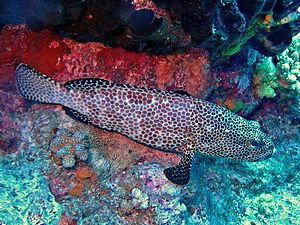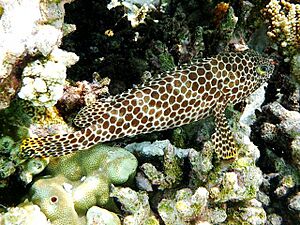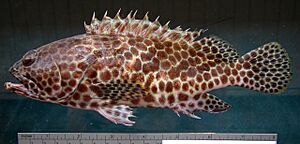Honeycomb grouper facts for kids
Quick facts for kids Honeycomb grouper |
|
|---|---|
 |
|
| Epinephelus merra from French Polynesia | |
| Conservation status | |
| Scientific classification | |
| Synonyms | |
|
The honeycomb grouper (Epinephelus merra) is a cool type of fish that lives in the ocean. It's also called the black-spotted rock-cod or wire-netting cod because of its unique pattern. This fish is a kind of grouper, which belongs to a larger family of fish called Serranidae. This family also includes sea basses.
You can find honeycomb groupers in many places. They live in warm, shallow waters near reefs.
Contents
Where Do Honeycomb Groupers Live?
The honeycomb grouper is a very common small grouper. It lives all over the tropical parts of the Indo-Pacific region. This huge area stretches from South Africa all the way to Pitcairn Island. You can also find them north of southern Japan and south of Lord Howe Island.
However, you won't find them in the Red Sea, the Persian Gulf, or near the coasts of India and Hawaii. In 2005, one was even seen in French Mediterranean waters, which was quite a surprise!
What Does a Honeycomb Grouper Look Like?

The honeycomb grouper can grow up to about 32 centimeters long. That's roughly the length of a school ruler! It's one of the smaller fish in its group, the Epinephelus genus.
This fish has a long fin on its back with eleven spines. It also has 15 to 17 soft rays in its dorsal fin and 8 soft rays in its anal fin. Its body is usually light brown or yellowish-brown. It's covered in small, brown, hexagon-shaped spots. These spots look like a network or a honeycomb pattern, which is how it got its name! You can see these spots on all its fins too.
The tail fin is rounded. The top of its head is flat between its eyes and curves upwards. Its eyes are round and have reddish-brown or black pupils. The lower jaw of the honeycomb grouper is longer than its upper jaw. It has a few rows of teeth on the sides of its lower jaw.
Honeycomb Grouper Life and Habits
These groupers usually live alone. They like to hang out in reefs that face the open ocean. You can also find them in shallow lagoons. They typically live in waters less than 20 meters deep, but sometimes they go as deep as 50 meters.
Young honeycomb groupers love to live among staghorn corals. These corals provide a safe place for them.
What Do They Eat?
Honeycomb groupers are predators. They mainly eat other fish, crabs, and shrimp. They also enjoy eating cephalopods, like squid. As they get older, they tend to eat more fish.
Reproduction and Life Cycle
Honeycomb groupers have a very interesting way of reproducing. When they are young, they are all females. But as they grow older, some of them change into males! This is a special ability called protogynous hermaphroditism.
Usually, groupers that are about 16 centimeters long are still females. The sex change often happens when they reach about 20 centimeters in length. This change usually takes place when it's not their breeding season. Scientists think this change can be triggered by things like their age, how big they are, or even how they interact with other fish.
These fish usually lay their eggs between January and April. The spawning, or egg-laying, starts a few days before the full moon and lasts for about three to four days.
How Honeycomb Groupers Change Sex
As mentioned, honeycomb groupers are protogynous hermaphrodites. This means they are born female and can later change into males. This amazing ability is found in many fish species, especially in the Epinephelus genus.
The reason they change sex is often linked to their size. This idea is called the "size advantage model." It means that if a fish can reproduce better as one sex when it's small, and better as the other sex when it's big, then it makes sense for it to change sex at some point in its life. For honeycomb groupers, being a larger male might give them an advantage in breeding.
Naming the Honeycomb Grouper
The honeycomb grouper was first officially described in 1793. A German scientist named Marcus Elieser Bloch gave it its scientific name, Epinephelus merra. He thought it came from the "Japan Sea," but it's now believed he meant the Indian Ocean.
This species is part of a group of similar fish in the Epinephelus genus. They are often called "reticulated coral groupers" because of their net-like patterns. Other fish in this group include E. bilobatus and E. hexagonatus. Because they look so similar, it has sometimes been hard for scientists to tell them apart.



